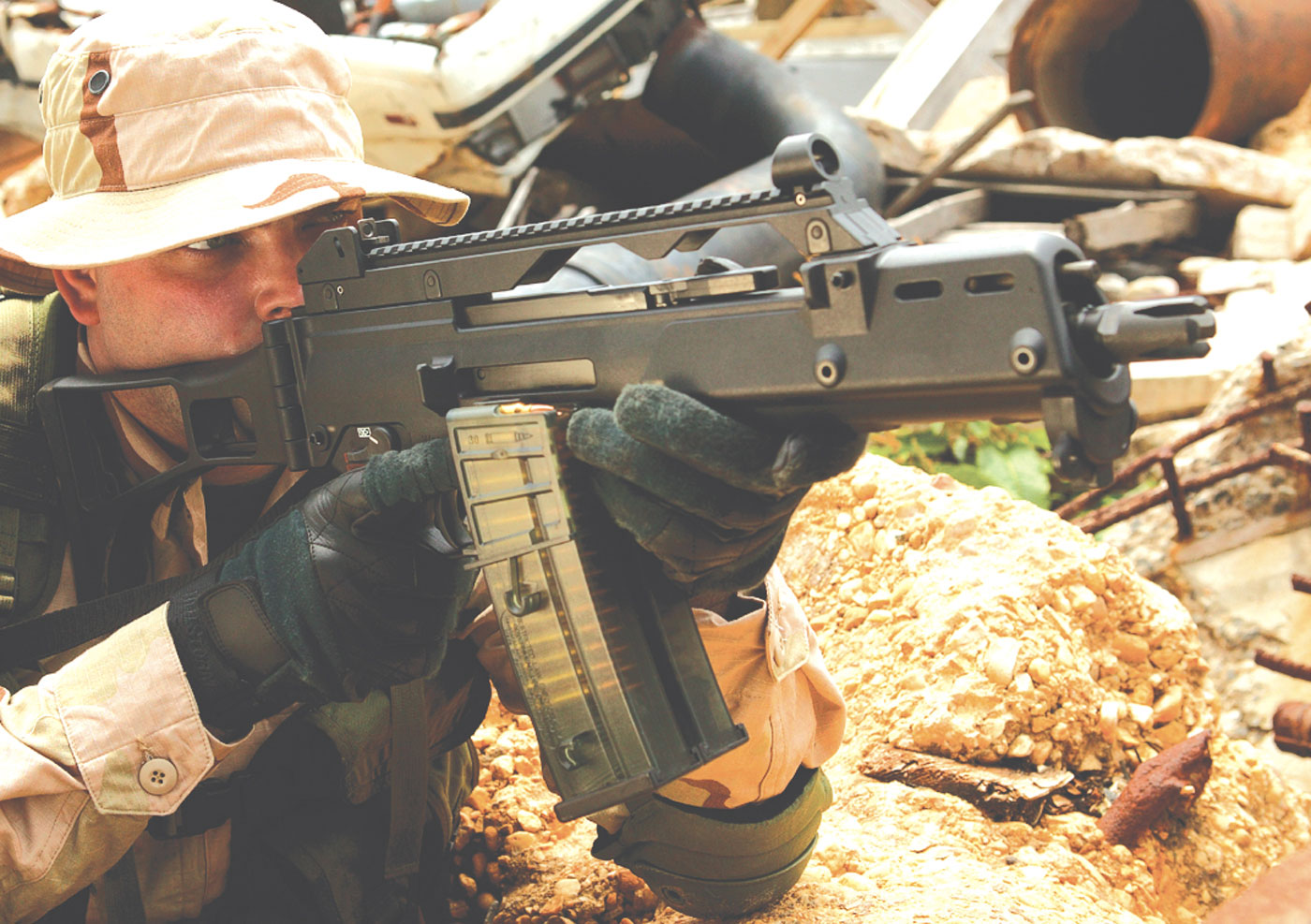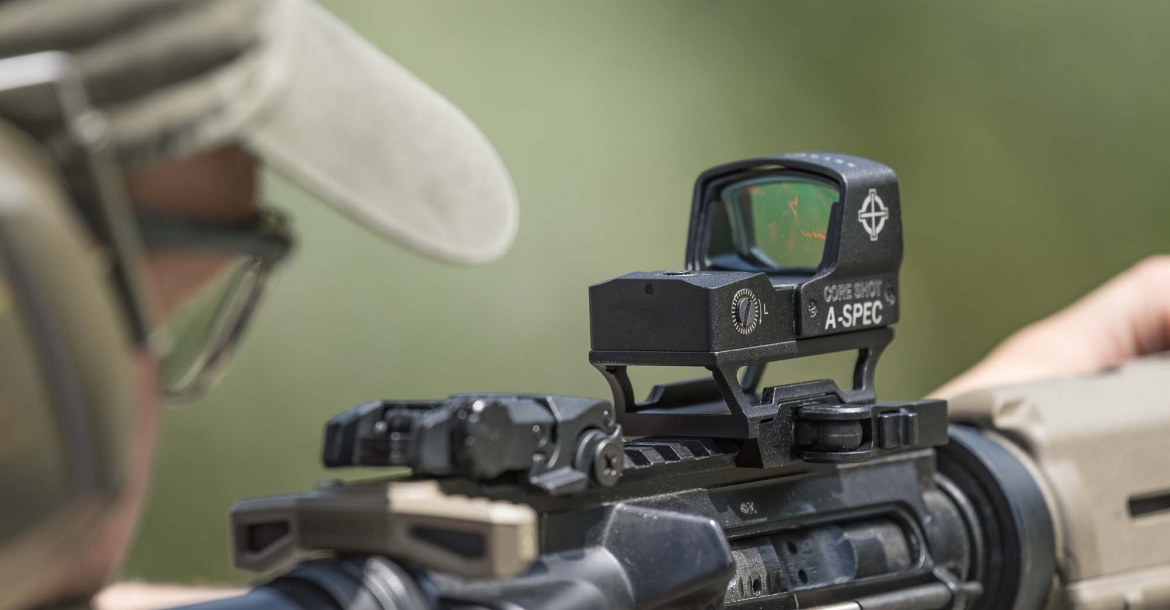
The close quarter battle (CQB) requires weapons that can be brought quickly onto a target, not to mention sights that allow quick and accurate shooting.
The dismounted ground battle can quickly become an intimate affair with encounters occurring at close quarters. In jungle, forests, urban areas, and broken terrain the very nature of the surroundings not only limits visibility to tens of meters but can effectively conceal a nearby enemy. Even the final dismounted assault can culminate in face-to-face close combat clearing enemy defensive positions. These are life-or-death situations where acquiring a target, engaging it quickly with accuracy despite tight quarters are paramount not just to success but to surviving. These realities of the close battle directly influence the weapons and sights best used.
QCB Combat Rifles
The standard infantry rifle’s length itself can be a disadvantage in close quarters. The M14 at 1.13 meter (44inch) and similar service rifles can be difficult to handle moving through dense vegetation, as proven in Vietnam. The length of a firearm can also hamper rapid training on threats especially in buildings or confined spaces. A retracting stock has been introduced in the US M4/M4A1 carbine; its 83cm (33in) can be reduced to 75cm (29.75in) making it handier in these situations. Heckler & Koch takes this further in its G36K compact (reduces to 61cm) and G36C ultra-short (shortened to 50cm) versions of its standard G36 rifle. Although these weapons use standard ammunition simplifying supply and assuring lethality even against body armour, their shorter barrel lengths of 27cm to 35cm (11in to 14in) reduces muzzle velocity. This impacts on performance at ranges beyond 400m. These are trade-offs that must be considered, especially in seeking a single rifle for broad use.

The 12 gauge shotgun has been considered an ideal close quarters weapon with its effectiveness demonstrated in the World War I trenches. A challenge for shotguns in the combat role is in providing adequate ammunition capacity. Mossberg’s 590M addresses this with a box magazine feed with five to 20 round capacities. The US Marines Benelli M4/M1014 semi-automatic shotgun is designed from inception for combat, with an extended seven round tube magazine, pistol grip, ghost sights, Picatinny rail and collapsing stock. The newly introduced Smith & Wesson M&P12 is not only compact with an overall length of 70.6cm (27.8in) but has an innovative two tube magazine design holding up to seven shells each. It also has two pistol grips and a picatinny-style rail for optics and aiming accessories, and accepts a sling. According to company representatives, the Smith & Wesson M&P12 is receiving a great deal of user attention. Again, the shotgun’s short range that makes it great for close combat also limits its general military use.
The pistol, on the other hand, is widely distributed as a side arm and can be effective in close quarters. Military models are generally magazine feed semi-automatics in 9mm or other pistol calibres. Submachine guns, like the Uzi and the B & T APC9K generally use pistol ammunition. Modest numbers of the later were purchased by the US Army in 2019. Manufacturers like H&K in its MP5 and UMP, as well as Colt’s 9mm SMG base them on their existing assault rifle designs. All demonstrate the advantage of being easily carried, quick to aim, and effective in close quarters, especially equipped with today’s reflex sights.

CQB Sights
Close combat engagements feature relatively short ranges with suddenly appearing and fleeting targets. Success, therefore, relies on rapidly detecting, aiming, and firing. The technique referred to as ‘point’ or ‘snap’ shooting uses both eyes, focusing on the target, aligning the front sight, and then taking the shot in under a second. It is a learned skill that takes practice with iron sights. However, an innovation by the company Aimpoint called ‘red dot optics’ place the target and reticle on the same optical plane. This offers a single focal point allowing almost intuitive aiming at typical meeting engagement ranges. The shooter places the ‘red’ (or green) aiming dot in the sight on the target and pulls the trigger. As Frank Martello, a former US Marine, 28 year law enforcement officer and president of Stafford Tactical a firearms training facility in Virginia explained: “the biggest benefit of the red-dot is that it provides a single point of reference…if you got the dot you got the shot. It will make a good shooter better.”
The red-dot has been adopted by the US, NATO, Russia, India, China, and others often using domestic manufacturers. This broad world-wide adoption of red-dot type sights for riflemen reflects an emphasis on relatively close-range engagement. It is a tacit recognition that for most tactical situations the rifleman’s primary task will be confronting enemies inside 200m.
Of the red-dot sights available, the tube style with enclosed optics has been especially popular for infantry weapons. Aimpoint’s Comp series, for example, is used by the US Army and Air Force as the M68 Close Combat Optic. The Reflex style red-dot, on the other hand, is particularly suited for close combat where its wide field of view allows rapid target acquisition and broad situation awareness. The Reflex is compatible with rifles, carbines, shotguns, submachine guns and pistols. They are also the most compact and lightest red-dots with Aimpoint’s newest, the Acro, weighting only 60 grams (2.1oz). Another ‘red-dot’ type sight is the Holographic, using a laser diode and mirror projecting the reticle on the target. Offered by EO Tech, Vortex and others, they allow a shooter to focus on both the target and reticle which can be faster in close quarters situations. In very close combat or inside a building many suggest a simple red-dot is preferable – fast and simple are better!

Another sight is the Prism with etched ballistic reticles and fixed magnification. Magnification offers better target identification than the red-dot, but by reducing the area seen through the sight makes acquiring a target more difficult. As a result, its use at close range can be tricky requiring training. This is a trade-off to be considered especially with a fixed magnification sight. The US Marines use of the Trijicon TA21 ACOG Rifleman Common Optic, a prism sight with 4X magnification, suggests a priority to target identification, shot placement and longer ranges.
The laser aiming sight is particularly suited to close encounters in that simply placing the projected laser dot tells the point of impact. It, thus, assures a hit regardless of the position of the weapon. They are well suited to rapid engagements and low-light conditions. The red laser can be difficult to see in some situations while the green laser is more visible even in bright daylight conditions and at longer ranges. However, red is lighter and less expensive than the green laser. Being an active illuminating source, both can be seen and reveal the shooters position. They are particularly obvious viewed through night vision devices, so, they are best employed briefly.
Future Combat
Despite technologies that allow engaging at extended distances military history reflects that combat at close quarters is inevitable. Armies, in pursing long range engagement, should beware of neglecting the CQB which can be not only vicious and personal but also decisive. It is, therefore, critical to provide soldiers every advantage in fighting these type of fights.
by Stephen W. Miller













